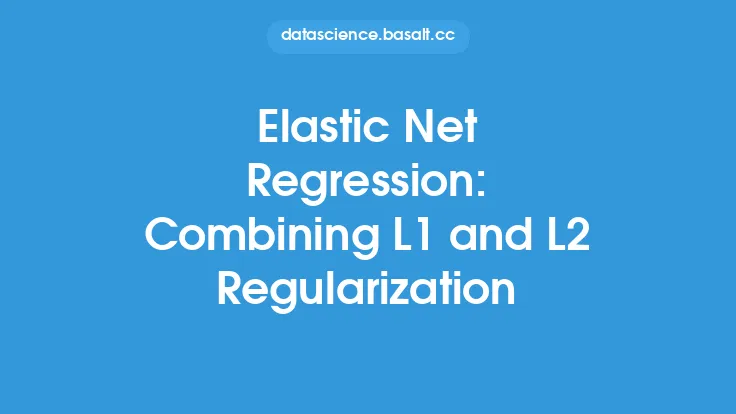Lasso regression, also known as L1 regularization, is a type of regression analysis that uses a penalty term to reduce the magnitude of model coefficients, effectively selecting the most relevant features in the data. This technique is particularly useful when dealing with high-dimensional data, where the number of features is large compared to the number of observations. In this article, we will delve into the details of lasso regression, its mathematical formulation, and its applications in feature selection and regression modeling.
Introduction to L1 Regularization
L1 regularization, also known as the least absolute shrinkage and selection operator (LASSO), is a technique used to reduce the complexity of a model by adding a penalty term to the loss function. The penalty term is proportional to the absolute value of the model coefficients, which encourages the model to reduce the magnitude of the coefficients. This results in some coefficients being set to zero, effectively selecting a subset of the most relevant features. The L1 regularization term is defined as the sum of the absolute values of the model coefficients, multiplied by a tuning parameter λ.
Mathematical Formulation
The mathematical formulation of lasso regression is based on the ordinary least squares (OLS) method, with an additional penalty term added to the loss function. The OLS method minimizes the sum of the squared errors between the observed and predicted values, while the L1 regularization term minimizes the absolute value of the model coefficients. The lasso regression model can be formulated as:
β = argmin(∑(y_i - x_i^T β)^2 + λ ∑|β_j|)
where β is the vector of model coefficients, y_i is the observed value, x_i is the feature vector, λ is the tuning parameter, and |β_j| is the absolute value of the j-th model coefficient.
Feature Selection
One of the key benefits of lasso regression is its ability to perform feature selection. By setting the tuning parameter λ to a non-zero value, the model will reduce the magnitude of the coefficients, effectively selecting a subset of the most relevant features. The features with non-zero coefficients are considered to be the most relevant, while the features with zero coefficients are considered to be irrelevant. The feature selection process in lasso regression is based on the concept of soft thresholding, where the model coefficients are reduced by a certain amount, rather than being set to zero abruptly.
Choosing the Tuning Parameter
The choice of the tuning parameter λ is critical in lasso regression, as it controls the amount of regularization applied to the model. A small value of λ will result in a model with a large number of non-zero coefficients, while a large value of λ will result in a model with a small number of non-zero coefficients. The tuning parameter can be chosen using cross-validation, where the model is trained on a subset of the data and evaluated on a separate subset. The value of λ that results in the best model performance is chosen as the optimal value.
Computational Algorithms
Lasso regression can be computationally expensive, especially for large datasets. Several algorithms have been developed to solve the lasso regression problem efficiently, including the least angle regression (LARS) algorithm and the coordinate descent algorithm. The LARS algorithm is a popular choice for solving lasso regression problems, as it is efficient and easy to implement. The coordinate descent algorithm is another popular choice, as it is highly efficient and can handle large datasets.
Applications
Lasso regression has a wide range of applications in statistics and machine learning, including feature selection, regression modeling, and prediction. It is particularly useful in high-dimensional data, where the number of features is large compared to the number of observations. Lasso regression is also useful in situations where the data is sparse, and the model needs to be regularized to prevent overfitting. Some examples of applications of lasso regression include:
- Gene selection in microarray data
- Feature selection in text classification
- Regression modeling in finance and economics
- Prediction in recommender systems
Advantages and Disadvantages
Lasso regression has several advantages, including its ability to perform feature selection, its robustness to outliers, and its ability to handle high-dimensional data. However, it also has some disadvantages, including its sensitivity to the choice of the tuning parameter, its computational expense, and its lack of interpretability. The advantages and disadvantages of lasso regression are summarized below:
Advantages:
- Feature selection: Lasso regression can select a subset of the most relevant features, reducing the dimensionality of the data.
- Robustness to outliers: Lasso regression is robust to outliers, as it uses the absolute value of the residuals rather than the squared residuals.
- Handling high-dimensional data: Lasso regression can handle high-dimensional data, where the number of features is large compared to the number of observations.
Disadvantages:
- Sensitivity to the tuning parameter: Lasso regression is sensitive to the choice of the tuning parameter, which can affect the model's performance.
- Computational expense: Lasso regression can be computationally expensive, especially for large datasets.
- Lack of interpretability: Lasso regression can be difficult to interpret, as the model coefficients are reduced by the L1 regularization term.
Conclusion
Lasso regression is a powerful technique for feature selection and regression modeling, particularly in high-dimensional data. Its ability to reduce the magnitude of model coefficients, effectively selecting a subset of the most relevant features, makes it a useful tool in statistics and machine learning. While it has some disadvantages, including its sensitivity to the tuning parameter and its computational expense, its advantages make it a popular choice in many applications. By understanding the mathematical formulation, computational algorithms, and applications of lasso regression, practitioners can use this technique to improve their models and make more accurate predictions.





